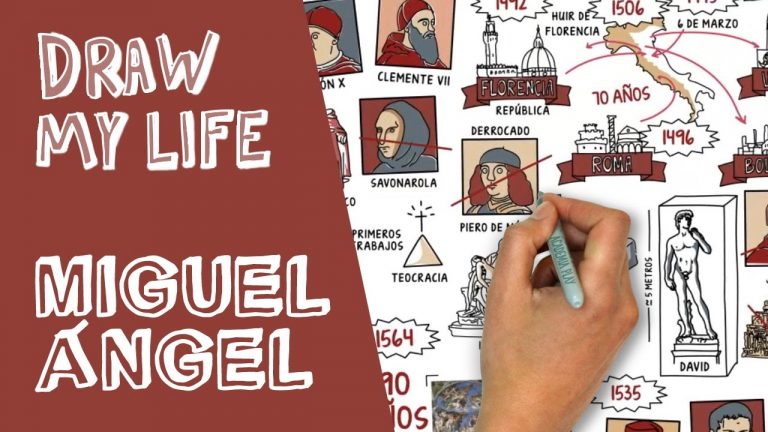Contenidos
Miguel ángel michelangelo buonarroti
pietà (michelangelo)
This work is clearly Michelangelo’s first great masterpiece, showing the constant characteristic of sexuality in his sculpture, symbolizing the spirit of classical hedonism that Savonarola and his followers were determined to suppress from Florence.
The sculpture was commissioned by Cardinal Riario, rejected by him, was bought and kept in the gardens of the banker Jacopo Galli, where it was drawn by Martin Heemskerck around 1532. The drawing showed the lack of her right hand, which was later restored. It was later acquired by Francesco I de’ Medici in 1572 until its transfer to the Bargello Palace in 1873.
michelangelo education
Ghirlandaio and sculpture in the garden of the Medici, who had assembled an exceptional collection of ancient statues. He took his first steps by making copies of frescoes by Giotto or Masaccio, which served to define his style.
In 1505, when he was working on the preparatory cardboard of the Battle of Cascina (unfinished) for the Palazzo Vecchio, Pope Julius II called him to Rome to sculpt his tomb; Michelangelo worked on this work until 1545 and finished only three statues, the Moses and two Slaves; He left half finished several statues of slaves that are nowadays among his most admired works, since they allow us to appreciate how he literally extracted from the marble blocks figures that seemed to be already contained in them.
Julius II also asked him to decorate the ceiling of the Sistine Chapel, a commission that Michelangelo was reluctant to accept, as he considered himself first and foremost a sculptor, but which eventually became his most sublime creation. Around the central scenes, depicting episodes from Genesis, a group of prophets, sibyls and naked youths unfolds in a unitary whole dominated by two essential qualities: physical beauty and dynamic energy.
michelangelo family
He maintained good family relations throughout his life. When his older brother, Leonardo, became a Dominican monk in Pisa, he assumed responsibility for the management of the family. He took care of the Buonarroti estate and expanded it with the purchase of houses and land, as well as arranging the marriage of his nephews Francesca and Leonardo to good families in Florence.[9] After the death of Julius II, he was responsible for the family’s wealth.
After the death of Julius II in May 1513, the artist made a second attempt to continue the work on the pontiff’s mausoleum. For this purpose he sculpted the two figures of the Slaves and the Moses, which reflect a tormented energy, Michelangelo’s terribilitá. But this second attempt did not succeed either.
In 1534, finding himself displeased with the new political situation that had been established in Florence, he left the city and settled in Rome, where he accepted a commission from Clement VII to work on the altar of the Sistine Chapel and where, between 1536 and 1541, he executed the magnificent Last Judgment. Until 1550 he worked on the tomb of Julius II and the frescoes of the Pauline Chapel (The Conversion of St. Paul and Crucifixion of St. Peter).
por qué era conocido miguel ángel
Michelangelo di Lodovico Buonarroti Simoni (italiano: [mikeˈlandʒelo di lodoˈviːko ˌbwɔnarˈrɔːti siˈmoːni]; 6 de marzo de 1475 – 18 de febrero de 1564), conocido simplemente como Miguel Ángel (inglés: /ˌmaɪkəlˈændʒəloʊ, ˌmɪk-/[1]), fue un escultor, pintor, arquitecto y poeta italiano del Alto Renacimiento nacido en la República de Florencia, cuya obra tuvo una gran influencia en el desarrollo del arte occidental, especialmente en relación con las nociones renacentistas de humanismo y naturalismo. A menudo se le considera un aspirante al título de hombre arquetípico del Renacimiento, junto con su rival y contemporáneo mayor, Leonardo da Vinci[2]. Dado el gran volumen de correspondencia, bocetos y recuerdos que se conservan, Miguel Ángel es uno de los artistas mejor documentados del siglo XVI y varios estudiosos han descrito a Miguel Ángel como el artista más consumado de su época[3][4].
Miguel Ángel fue el primer artista occidental cuya biografía se publicó en vida[2]; de hecho, se publicaron dos biografías en vida. Una de ellas, de Giorgio Vasari, proponía que la obra de Miguel Ángel trascendía la de cualquier artista vivo o muerto, y que era “supremo no en un solo arte, sino en los tres”[6].






